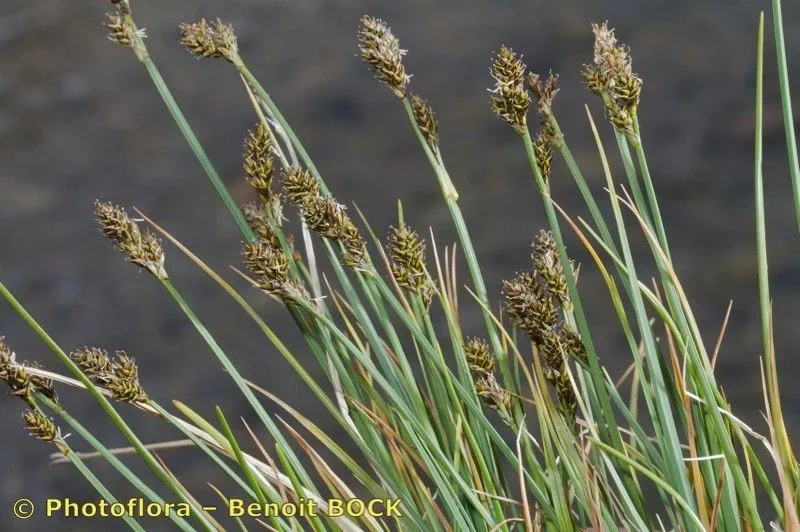
Author: Schkuhr
Bibliography: Beschr. Riedgräs. 1: 51 (1801)
Year: 1801
Status: accepted
Rank: species
Genus: Carex
Vegetable: False
Observations: Temp. & Subarctic Northern Hemisphere, New Zealand
Twotipped sedge (Carex lachenalii), described in 1801 by Schkuhr in “Beschr. Riedgräs. 1: 51”, is a unique species belonging to the Cyperaceae family. This resilient and adaptive plant is native to temperate and subarctic regions of the Northern Hemisphere, including areas as far-reaching as New Zealand.
Carex lachenalii, recognized for its distinctive two-tipped structure, thrives in colder climates where it plays a crucial role in the ecosystem. It can be found in a variety of habitats, from wet meadows and marshes to alpine and tundra environments, showcasing its adaptability to varying moisture levels and soil conditions.
The twotipped sedge is an essential component of its natural habitat, providing ground cover and stability to the soil, thus preventing erosion. This species is also an important food source for various wildlife, including insects and herbivores that depend on it for sustenance during the growing seasons.
Botanists and ecologists value the twotipped sedge for its environmental contributions and its role as an indicator species of healthy wetland and tundra ecosystems. Its presence signifies a well-balanced, thriving environment, which is vital for the biodiversity of these regions.
Understanding and preserving Carex lachenalii is crucial for maintaining the ecological integrity of the areas it inhabits. Ongoing research and conservation efforts help ensure that this hardy sedge continues to flourish, supporting biodiversity and natural processes in its native regions.
Fin: riekonsara
Swe: riekonsara, ripstarr
Nob: rypestarr
Nno: rypestorr
Pol: turzyca lachenala
Eng: twotipped sedge, hare’s-foot sedge, lachenal’s sedge, twoparted sedge, arctic hare’s-foot sedge, two-parted sedge, two-tipped sedge
Fra: carex de lachenal, laiche de lachenal
Sme: rievssatlukti
Cym: hesgen droed-sgwarnog, hesgen troed ysgyfarnog
Nor: rypestarr
Gla: seisg cas maighiche
En: Twotipped sedge, Arctic Hare’s-foot Sedge, Two-tip Sedge, Two-tipped Sedge, Arctic Hare-Foot Sedge, Twoparted Sedge, Hare’s-foot Sedge, Lachenal’s sedge, Two-parted sedge
Zh: 二裂薹草
Cs: Ostřice svišťová
Fi: Riekonsara
Fr: Laiche de lachenal, Carex de Lachenal, Laîche de Lachenal, Laiche patte-de-lièvre, Laîche patte-de-lièvre
De: Hasenpfoten-Segge, Lachenals Segge
It: Carice di Lachenal
Se: Rievssatlukti
No: Rypestarr
Nb: Rypestarr
Nn: Rypestorr
Pl: Turzyca Lachenala
Gd: Seisg Cas Maighiche
Sv: Ripstarr, Riekonsara
Cy: Hesgen troed ysgyfarnog, Hesgen Droed-Sgwarnog
Taken Jul 15, 2010 by Photoflora – Benoit BOCK (©)
Taken Jul 15, 2010 by Photoflora – Benoit BOCK (©)
Taken Aug 15, 2012 by Photoflora – Jean-Luc TASSET (©)
Taken Jan 1, 1900 by EOL − Encyclopedia of Life (cc-by-nc)
Taken Jan 1, 1900 by EOL − Encyclopedia of Life (cc-by-nc)
Taken Aug 15, 2012 by Photoflora – Jean-Luc TASSET (©)
Taken Aug 15, 2012 by Photoflora – Jean-Luc TASSET (©)
Taken Aug 15, 2012 by Photoflora – Jean-Luc TASSET (©)
Taken Aug 15, 2014 by Photoflora – Jean-Luc TASSET (©)
Taken Aug 15, 2014 by Photoflora – Jean-Luc TASSET (©)
Taken Jan 1, 1900 by EOL − Encyclopedia of Life (cc-by-nc)
Taken Jan 1, 1900 by EOL − Encyclopedia of Life (cc-by-nc)
Taken Jan 1, 1900 by EOL − Encyclopedia of Life (cc-by-nc)
Taken Jan 1, 1900 by EOL − Encyclopedia of Life (cc-by-nc)
Taken Jan 1, 1900 by EOL − Encyclopedia of Life (cc-by-nc)
© copyright of the Board of Trustees of the Royal Botanic Gardens, Kew.
Taken Mar 18, 2020 by Jean-Noel Fourtier (cc-by-sa)
Taken Feb 11, 2020 by Fennec Aurora (cc-by-sa)
Taken Aug 15, 2005 by Photoflora – Jean-Luc TASSET (©)
Taken Aug 15, 1998 by Photoflora – Benoit BOCK (©)
Taken Jul 15, 2010 by Photoflora – Benoit BOCK (©)
Taken Jan 1, 1970 by Photoflora – L’Abbé COSTE (©)
Taken Jan 1, 1970 by Photoflora – L’Abbé COSTE (©)
Growth habit: Graminoid
Ph maximum: 4.5
Ph minimum: 4.0
Light: 8
Atmospheric humidity: 8
Bloom months: [‘jul’, ‘aug’]
Soil nutriments: 4
Family: Myrtaceae Author: (F.Muell.) K.D.Hill & L.A.S.Johnson Bibliography: Telopea 6: 402 (1995) Year: 1995 Status:…
Family: Rubiaceae Author: Pierre ex A.Froehner Bibliography: Notizbl. Bot. Gart. Berlin-Dahlem 1: 237 (1897) Year:…
Family: Sapindaceae Author: Koidz. Bibliography: J. Coll. Sci. Imp. Univ. Tokyo 32(1): 38 (1911) Year:…
Family: Asteraceae Author: A.Gray Bibliography: Pacif. Railr. Rep.: 107 (1857) Year: 1857 Status: accepted Rank:…
Family: Fabaceae Author: Medik. Bibliography: Vorles. Churpfälz. Phys.-Ökon. Ges. 2: 398 (1787) Year: 1787 Status:…
Family: Aspleniaceae Author: (Cav.) Alston Bibliography: Bull. Misc. Inform. Kew 1932: 309 (1932) Year: 1932…